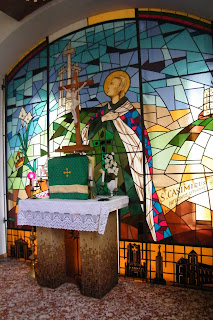In 1969 Father Spurgis came from Chicago to lighten the duties of the ailing priest at that time Father Kazlauskas. Father Spurgis initiated a comprehensive works program. Under his guidance a national shrine was erected, a baptistery and five stained glass windows commemorating the five diocese of Lithuanian were added to the chapel. Father Spurgis had envisaged a church decorated in stained glass depicting Lithuania. In total the windows cost over $10,000, produced in the early 1970’s. The windows were built by artist Stasys Kerulis.
The largest of the stained glass windows depicts St Casmir, patron saint of Lithuania. The window is located behind the alter. To the far right you can see Gediminas tower.
Gediminas' Tower s the only remaining part of the Upper Castle in Vilnius. It is an important state and historic symbol of the city of Vilnius and of Lithuania itself. It is depicted on the national currency, the litas, and is mentioned in numerous Lithuanian patriotic poems and folk songs.
To the left of St Casmir is the Three Crosses (Lithuanian: Trys kryžiai) based on a monument in Vilnius. Designed by Polish–Lithuanian architect and sculptor Antoni Wiwulski in 1916, it was torn down in 1950 by order of the Soviet Union authorities. A new monument designed by Henrikas Šilgalis was erected in its place in 1989. The crosses stand on Kalnai Park, overlooking the old town of Vilnius, very close to Gediminas’ tower.
Saint Casimir Jagiellon (Lithuanian: Kazimieras; October 3, 1458 – March 4, 1484) was a crown prince of the Kingdom of Poland and of the Grand Duchy of Lithuania who became a patron saint of Lithuania, Poland, and the young. His feast day, the Saint Casimir's Day, is marked annually with Kaziuko mugė (a trade fair) held on the Sunday nearest to March 4, the anniversary of his death, in Vilnius. Surviving contemporary accounts described Prince Casimir as a young man of exceptional intellect and education, humility and politeness, striving for justice and fairness.
He is usually depicted as a young man in long red robe lined with sloat fur. Sometimes he wears a red cap of the Grand Duke of Lithuania, but other times, to emphasize his devotion to spiritual life, the cap is placed near Casimir. Usually he holds a lily, a symbol of virginity, innocence, and purity. He might also hold a cross, a rosary, or a book with words from Omni die dic Mariae (Daily, Daily Sing to Mary). He was canonized by Pope Adrian VI in 1522 and is the patron saint of Poland and Lithuania.




No comments:
Post a Comment